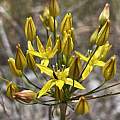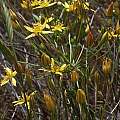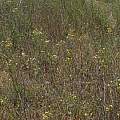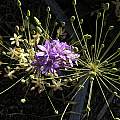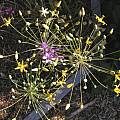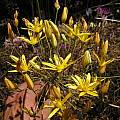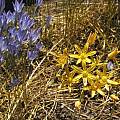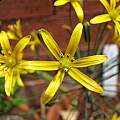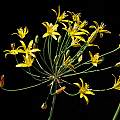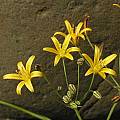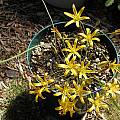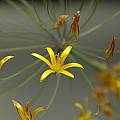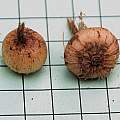Bloomeria is a genus with only 3 species which is native to the dry foothills of southern California and Baja Mexico where it is found in grasslands, open woodlands, or the edge of chaparral. This genus has been considered to be a member of many different families in the past (Amaryllidaceae, Liliaceae, Alliaceae). In 2001 it was placed in a new family, Themidaceae, which included other California genera (Androstephium, Brodiaea, Dichelostemma, Dipterostemon, and Triteleia) and some Mexican genera with corms. APG III and IV include this genus into an expanded Asparagaceae in a branch with Hyacinthaceae by placing most taxa into the subfamily Brodiaeoideae. The Jepson eFlora in 2021 continues to place it in Themidaceae and the Flora of North America in Liliaceae. Bloomeria looks superficially much like Allium but each anther filament bears a cup-like appendage at its base.
Bloomeria clevelandii S. Watson is native to scrub and coastal grassland from southern California (W. San Diego Co.) to northern Baja California, Mexico. It differs from the other species by having filaments that lean away from style, leaving dilated bases separated, not forming a cup. Height: to about 70 cm. Photos from iNaturalist taken by Madeleine Claire in April in San Diego County and shared under a CC BY-NC license.
Bloomeria crocea (Torr.) Coville is founds in chaparral, coastal sage scrub, Valley grassland, southern oak woodland, foothill woodland, and yellow pine forest from central California to Baja. It flowers April to June. Height: about 60 cm. There are three varieties: Bloomeria crocea var. aurea (Kellogg) Ingram, Bloomeria crocea var. crocea, and Bloomeria crocea var. montana (Greene) Ingram distinguished by the size of the nectar cup and variations in the filaments. It is shown in various stages of bloom in the pictures shown below. Bloomeria looks good massed and blends nicely with other yellows and with the blues of triteleias, dichelostemmas, and brodiaeas. Photos below show a series of bloom; photos 1, 3, 4 were taken by Bob Rutemoeller and photo 2 was taken by Mary Sue Ittner. Photo 1 is when it was in bud and a Dichelostemma multiflorum is coming up through the umbel and Triteleia ixioides is below. In photo 2 the flowers are starting to open. In photo 3 the flowers are fully open and in the last picture it is growing with Triteleia laxa. The leaves have all dried up by this time. Photos 5-6 were taken by Nhu Nguyen showing a closeup of the petals and pollen, and the whole umbel.
Bloomeria humilis Hoover is a rare plant known from only two populations in San Luis Obispo County where it is found on open grasslands and the edge of chaparral. It is a much shorter plant (15 cm tall) with lobes that ascend at the base and then spread. Photos by Mary Sue Ittner. The first photo was taken as the flowers were first starting to bloom. The second was taken a week later when most of the blossoms were open and giving you an idea of how many flowers in a pot can be in bloom at once. The third photo was taken almost a month after the first as the last flowers were opening. At this stage the petals look narrower than they did in the beginning and more spreading. It makes you realize how difficult it is to create keys as flowers change over time. The last photo shows the corms on a 1 cm grid.
